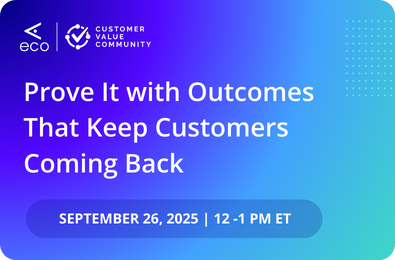Your business offers unique value to your customers, but do your customers understand the value they’re getting from your solutions? If you used a value-selling approach, your customers likely chose to work with you because of the value they were promised during the sales cycle. But have they seen that value come to life?
If you’re unsure of the answers to these questions, you need to reevaluate how you communicate the value you’re delivering to your customers. You need to be able to accurately track, measure, and articulate value achievement and realization. Why? Because when customers understand the value they’re getting from their relationship with your business, they are more likely to be loyal to your brand–and are more open to considering additional products or services from your organization.
Understanding Value Realization
Value realization refers to the process of ensuring that the value that was promised to customers during the sales cycle is fully realized in the real world. It’s a tangible way of tracking the actual impact your solutions have on your customers’ businesses. To learn more, see What is Value Realization and Why Does it Matter?
How to Track Value Achievement and Realization
Tracking value achievement and realization is key to helping your business improve customer satisfaction, increase customer retention and loyalty, and ultimately drive both recurring and new revenue through upsell and cross sell opportunities. By monitoring key performance indicators (KPIs), you can ensure that your organization is consistently delivering value to customers. And you can more easily identify accounts that may be at risk, so you can pivot accordingly.
The following are the four fundamental steps to start tracking value achievement and realization for your customers:
1. Create a Value Realization Framework
A value realization framework is a documented approach to tracking customer value. It is ultimately a roadmap for how you will measure, monitor, and communicate success metrics with your customers. It is important to remember that most customers don’t have their own value realization frameworks in place, so you should be prepared to provide a value realization framework for them to demonstrate the impact of your solution on their business.
While there are a number of different frameworks, at Ecosystems we like to use the Value Trinity, which is built around 3 interlocking aspects of human decision-making: logic, emotion, and credibility. This framework allows you to show the value of your solution across these 3 dimensions in a very powerful way that drives customer stickiness. Learn more about the Value Trinity.
2. Measure Value Realization by Tracking the Right KPIs
Now that you have a framework in place, you need to choose the right metrics to track for each of your customers. The exact metrics you choose to track can and should vary by customer, as you tailor value to each customer’s unique needs and priorities. However, there are three fundamental KPIs that you should be reporting for each and every customer:
- Net Dollar Retention (NDR)/Net Revenue Retention (NRR): NDR and NRR calculate the percentage of revenue retained from existing customers, accounting for upgrades, downgrades, and churn. A high NDR or NRR indicates that customers find value in your products or services and are willing to invest more or maintain their current investment.
- Time to Solution Go-Live: This KPI measures the time it takes for a solution to be fully off the ground and deliver value to your customers. A shorter time to solution go-live indicates a more efficient implementation process and a quicker path to value realization for customers.
- Time to Solution Value: This KPI tracks the time it takes for customers to start realizing value from your product or service. The shorter the time to solution value, the better the customer experience.
For more ways to improve your value realization metrics, see 5 Ways to Improve Your Value Realization Metrics Right Now.
3. Use Technology to Monitor, Measure, & Communicate Value
Next, you’ll likely find that you need to automate certain aspects of your value realization workflows. You can, of course, track these metrics manually, but that can be a major drain on your resources. Instead, a value realization platform technology makes it faster and easier to monitor, measure, and communicate value tailored to each customer, without overloading your customer success team with administrative tasks.
For example, a robust analytics and reporting platform makes it easy to instantly communicate results with customers and quickly adapt to the customer’s needs. A tool like this can also offload mundane data entry tasks and improve information sharing between teams. A value platform with these capabilities sets your team up for success by giving them more time to focus on customer relationships, so your customers can enjoy a seamless and personalized experience.
4. Set up Regular Value Reviews
Finally, it is important to conduct regular value reviews with your customers. Customers should have direct access to measurement dashboards via a customer value platform, as well as regularly scheduled check-ins and value reviews with key stakeholders. Recently, these types of meetings have evolved from operational results to quarterly business reviews (QBRs) to now value reviews. These reviews provide an opportunity to assess the value delivered to customers, discuss any challenges or issues, and identify areas for improvement.
To learn more about evolving your business reviews to value reviews, watch this on-demand webinar: Evolving Your Quarterly Business Reviews into Value Reviews.
Level Up Your Value Realization Tracking
Tracking value achievement and realization is essential for improving customer retention and loyalty, as well as growing your revenue. To take your value realization tracking to the next level, schedule a demo with a value realization expert today.
























